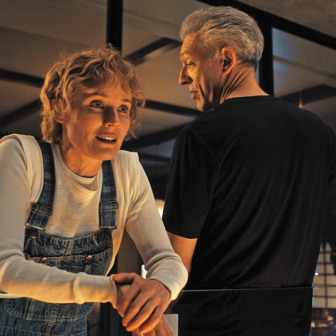There’s an unlikely connection between the Salvation Army, Ned Kelly and a giant film corporation. It starts in Sydney’s Centennial Park on 1 January 1901.
With the several colonies about to federate as the Commonwealth of Australia, the dignitaries move in solemn procession towards the rotunda for the swearing-in of the first governor-general of the first federal ministry. But there’s a larrikin moment: the elegantly togged governor-general, the Earl of Hopetoun, holds up the show by ducking aside to say g’day to a mate. This instant isn’t caught in the official photographs. So how do we know it happened?
Because it’s in the film. Australia was the first country to be born in front of a movie camera. The Federation ceremonies and procession were captured as a living documentary record — by the Salvation Army, no less, which was already expert in the new technology. Its Limelight Department, led by Major Joseph Perry, had been contracted to make this first-ever motion picture film using multi-camera positions: all thirty-five minutes of it. It is preserved at the National Film and Sound Archive, or NFSA.
One first led to another. Australia invented the feature film in 1906 when Joseph Perry’s sons, Orrie and Reg, filmed The Story of the Kelly Gang. The footage was processed by a chemist named William Gibson, who went on to found the film production and exhibition conglomerate known today as Event Hospitality and Entertainment. It’s a sequence of pioneering, mentoring and building.
The arrival of the movie camera, along with mechanical recordings such as phonograph cylinders, discs and piano rolls — to be followed by radio and television — opened up previously unimaginable ways of understanding the world. But preserving these new, constantly evolving formats meant rethinking how we store, organise, curate and exhibit. It required a new kind of institution — the audiovisual archive — along with a new breed of people to run it. These archives were pioneered, naturally, in Europe and North America — but also, surprisingly, in Australia.
Federal cabinet created the National Historical Film and Speaking Record Library in December 1935. Administratively linked to what was then the Commonwealth National Library, it was arguably the first such entity to perceive the logic of preserving moving images and recorded sound together rather than separately.
That’s eighty-six years ago. It was a tortuous journey from 1935 to 1984, when what became the NFSA was unhooked from the National Library (although it had to wait another twenty-four years to gain statutory status). On the way it was often a case of too little, too late, which is why far too much of our audiovisual heritage has been lost or imperfectly preserved.
But from 1984 onwards the NFSA quickly made its mark as a pacesetter, not only enlarging the national collection and technical expertise at home, but also serving as the go-to reference point for emerging archives across Southeast Asia and the Pacific. Its innovative collection-management software was adopted by the US Library of Congress. It launched the first (and currently still the only) online postgraduate training course in audiovisual archiving, now offered through Charles Sturt University. It developed the foundational UNESCO textbook on the philosophy and principles of audiovisual archiving that now, in multiple languages, underpins the global profession.
Domestically, the NFSA’s collections have served as a resource for creators in the burgeoning film, television, radio, recorded sound and games industries. Without knowing it, every week millions of Australians watch or hear something from the NFSA collection — perhaps in a documentary or feature film, or on TV news or radio.
Screenings and exhibitions at the NFSA’s Canberra headquarters have been a tourist magnet; travelling festivals have toured the country and overseas. Its five-year-long Operation Newsreel project, launched in 1988 with $4 million in corporate sponsorship, worked to safeguard seven decades of Australian cinema newsreels. A long succession of feature films, television and radio series, and web resources have relied on individual staff members’ intimate knowledge of the NFSA’s collections.
Over the years, the NFSA has produced its full share of internationally recognised experts who have led a staff of passionate and technically adept people. It is fulfilling work: seeking, finding and restoring what has been lost — some of the missing episodes of Blue Hills, say, or an early Cinesound newsreel — offers a satisfaction that can’t be put into words. Keeping obsolete technology functioning requires specialised knowledge and inventiveness; so does anticipating the next phase of technological evolution. And recalling the context and significance of undocumented collection items relies on living corporate memory.
But audiovisual archiving also operates in a public service environment where managerialism trumps curatorial expertise. You don’t do it for the money or the fame, and the commitment and passion don’t end when people retire or leave. An individual’s curatorial memory, contacts and knowledge are unique, and therein lies a dilemma.
Each departing expert is a piece removed from the corporate memory bank. Newer staff are ever more distant from the worldview, knowledge and historical experience of those who built and know the collections they inherit. Memory loss starts to endanger the performance of the institution and the integrity of its collections. Policies and practices evolve without reference to wider curatorial memory. And unless staff already recognise what they don’t know, and therefore need to seek out, it can happen unconsciously.
Recently the NFSA put out to tender seventy-seven pallets of collection items judged surplus to requirements. They included a unique and precious collection of Australian piano rolls — the in-house archive of the eighty-eight-year-old Mastertouch company, which closed in 2005. The media treated it all as a novelty item, a collector’s dream of old curios now up for grabs. But some former senior staff members, acknowledged specialists in Australia’s sound-recording history, were blindsided by the announcement and alarmed at the prospective cultural vandalism — arising, apparently, from insufficient knowledge of the central place piano rolls have in our musical and social history.
The chair of the NFSA board defended the move as “the culmination of many years of work by our senior executive, curatorial, preservation and collection management teams.” After a “rigorous selection process” and “very careful consideration” it had been determined that the material fell outside the scope of the 2020 Collecting Policy. Four retired NFSA staff members sought an urgent meeting with NFSA executives to urge a rethink. The outcome is pending.
While the National Film and Sound Archive Act requires the institution to “work to the highest curatorial standards,” this incident illustrates how standards are affected by generational memory loss. It is a serious problem for audiovisual archives globally, and is currently the focus of Share That Knowledge!, a three-year international study helmed by the Austrian Film Museum in Vienna, with twelve partners including the NFSA. While the study’s outcome won’t be known until the end of 2022, some preliminary findings are clear.
By its very nature, curatorial knowledge is often not formally recorded. But it remains in the memory of former staff and board members who want to keep it available — as volunteer mentors, trainers, consultants and advisers. They want to stay connected to the institution that, for so many of them, has been an integral part of their life’s work. To do this, they need to be invited back into the tent.
The analogies of the apprentice or the football coach are not out of place here. It takes many years to become familiar with a complex collection, to develop technical skills and knowledge, to build relationships with collectors, creators and users, to grow in the scholarship of the audiovisual media — and to imbibe the enthusiasm and passion that have impelled others into the profession.
Like other federally funded institutions, the NFSA has suffered years of compounding “efficiency dividends.” These have translated into early retirements and redundancies for staff who, in some cases, were global leaders in the profession. Instead of growing, the NFSA has been hollowed out and squeezed to the point that it now employs one-fifth fewer staff than it did a decade ago, despite a vast increase in its workload.
Attention and resources have had to be increasingly focused on large-scale digitisation: the NFSA holds by far Australia’s largest collection of at-risk magnetic tape formats but also needs to make the wider collection accessible in the digital form that is now expected. Nor is this a one-off: with standards constantly evolving, digitisation and file maintenance is an unending process. Collections are permanently on life support.
So the circle keeps getting smaller. The visitor shop has closed; fellowships and research have faltered; the library has been shut; public programs have been trimmed; travelling festivals have ended; school visits have been curtailed; public lectures and award systems have been dropped; interaction with professional communities has shrunk. Keeping the remaining balls in the air has become ever harder. Volunteers, whether former staff or not, can help. But unlike the other national memory institutions, the NFSA has not yet developed an integrated volunteer culture.
When the NFSA gained statutory status in 2008, members of its first governing board were chosen from the advocacy bodies and stirrers who had worked long and hard for this outcome. They brought to the task their shared knowledge and vision for the organisation, relevant professional disciplines, and connections to stakeholder communities and sponsors. At the time, board chair Chris Puplick noted that “the poachers had been appointed as the gamekeepers and had to deliver on the claims they had made about the benefits of their preferred course of action.”
Like its international peers, the NFSA — and therefore Australia’s audiovisual heritage — had, at long last, achieved the same status as the other national memory institutions, and now had the ability to chart its own professional course.
Now the original stirrers, with their professional disciplines, have gone. Along with diminishing corporate memory, the board has lost close contact with, as well as the confidence of, important contributors and users in the audiovisual industries. After nearly a decade of virtually ignoring its voluntary Friends association, the board has recently rediscovered it, though it is unclear whether it also comprehends the character of the NFSA’s generational problem. It will shortly gain a new chair, who will find ways, it’s to be hoped, of enlarging the circle of engagement.
Australia’s opaque system of ministerial appointments to public authorities tends to mould boards into quiescent extensions of the government of the day rather than independent advocates, stakeholders or experts. But the board has the responsibility to lead the institution to the standards required by the National Film and Sound Archive Act for the benefit of present and future generations.
Persuading the government to provide adequate funding isn’t easy, of course, as the recent campaign for the National Archives of Australia shows. Only under immense pressure did the government agree to provide an emergency allocation to the NAA of just $67 million over four years.
The NFSA’s board is also responsible for appointing and guiding the organisation’s chief executive. Over the past decade it could have undertaken succession planning, nurturing the institution’s potential leadership pool within the national profession. Instead it chose to replace one leader from overseas with another. Although they came with impeccable credentials, made a significant contribution and did the best job they could, they faced the obvious disadvantage of building new relationships in a new country and adapting to a new bureaucratic system. They have since returned home and taken their memory with them.
The NFSA’s next chief executive, Patrick McIntyre, is an Australian and comes with a broad arts administration background, most recently with the Sydney Theatre Company. When he begins settling into the milieu of the national memory institutions in October he will potentially have the support of the NFSA’s stakeholders in establishing partnerships with industry, philanthropists and sponsors who can financially support major projects and activities, as the institution did so successfully in the now-distant past.
The baseload cost of sustaining the NFSA’s physical establishment and services, and its roster of permanent staff, falls where it belongs: on the government. It is unreasonable to expect a shrinking institution to manage the ever-expanding demands of access and collection growth. To restore its budget and staffing to real 2008 levels would take an extra $6 million or so each year: not much to ask in the great scheme of things. The recent special allocation of $5.5 million over four years to increase the rate of digitisation, welcome as it is, hardly changes the bigger picture. Rebuilding won’t happen overnight, but it is the board’s responsibility to advocate for it. Otherwise the closures and retreats of the last decade cannot be reversed.
Paradoxically, the most immediately essential part of the resource equation has little financial cost, but requires time and attention by the board and management. Television, film and game producers; radio stations; podcasters; musicians; new-media pioneers; writers and academics; advocacy groups; donors; the NFSA’s various publics; those who need the institution for their creative and research output — all of these stakeholders need to be brought back formally into the NFSA’s orbit via workshops, advisory committees, surveys, interviews and mentoring. They deserve a voice in policymaking, collection development and service provision: their knowledge and wisdom needs to be taken seriously and the institution will be the stronger for it.
And this brings us to connecting today’s NFSA custodians with the fund of curatorial knowledge held by the NFSA’s wider community. Collectively, all are part of a remarkable institution of which the nation can be justly proud. Nothing is more important to an audiovisual archive than the depth of the relationships and knowledge that sustain it.
With every acknowledgement of Country and honouring of Indigenous elders, the NFSA should be reminded of the efforts of its own elders to volunteer their services in a structured way, working alongside the current knowledge- and memory-makers in the audiovisual field, and its emerging leaders. And we need to remember why the NFSA is as essential now as it was in that visionary moment of creation in 1935. •




